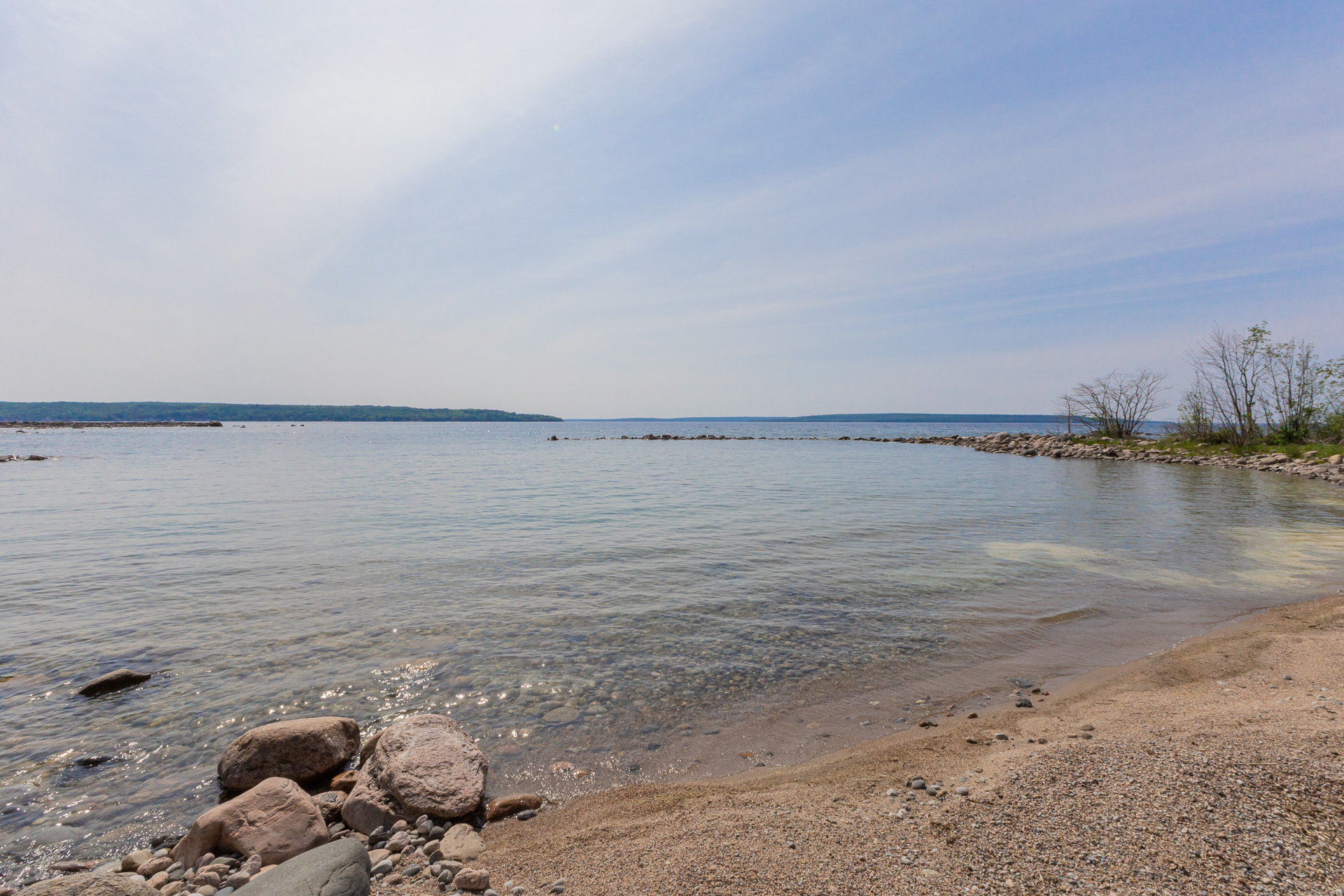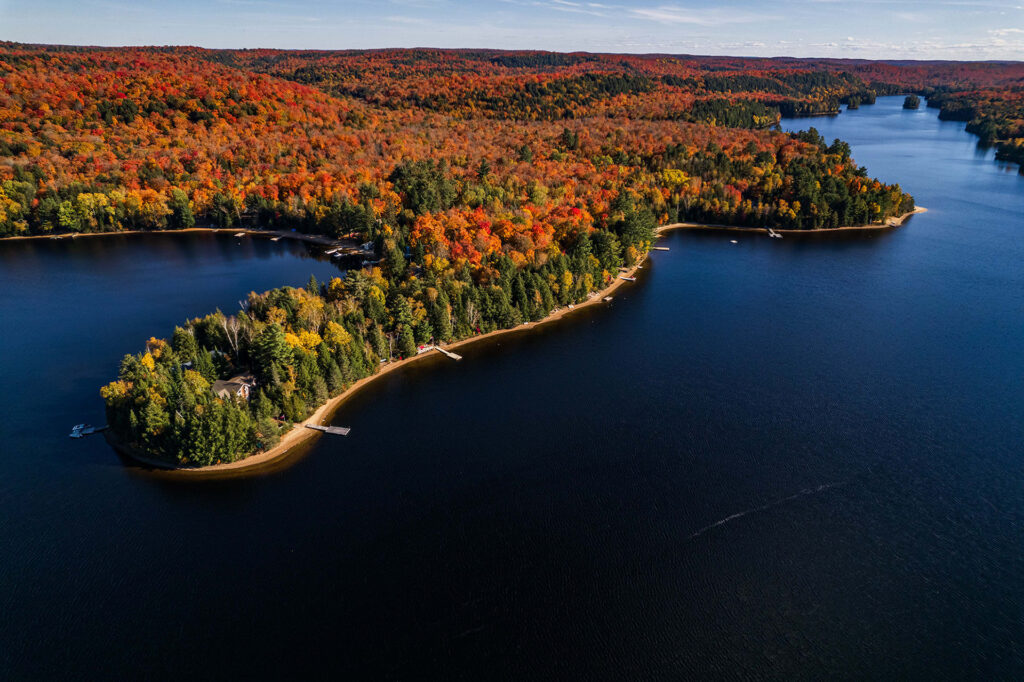Best Fishing Lakes in Ontario Cottage Country
The best fishing lakes in Ontario’s Cottage Country are renowned for their abundant and diverse types of fish, clear waters, and beautiful scenery. Here is a guide to some of the best reviewed lakes in the area, both big and small.
Explore Ontario’s Best Lakes for Fishing
- Lake Muskoka
- Lake Joseph
- Lake Rosseau
- Lake of Bays
- Georgian Bay
- Pickerel Lake
- Oxtongue Lake
- Lake Nipissing
- Skeleton Lake
- Ahmic Lake
Remember, all fishing in Ontario requires a fishing license. Once you’ve chosen a lake, you can figure out fishing permits, cottage boat rentals and the types of fish you’ll encounter in Ontario lakes.

Lake Muskoka
One of the three main interconnected Muskoka lakes, (along with Joseph and Rosseau) and the namesake for the region, Lake Muskoka is abundant with Bass, Pike, and Muskie. With an area of 137 square kilometers,130 kilometers of shoreline, and a plethora of bays, points, and islands, it has tons of space to explore. The most abundant fish are Walleye, Smallmouth Bass, and Northern Pike, with a wide range of other types of fish. Its beauty is no longer a secret, as the lake has been an attraction to some of the world’s famous and wealthiest people, like Tom Hanks, Steven Spielberg, and the Carnegy family, who have ornate cottages in an area near Beaumaris dubbed “Millionaire’s Row.”
Lake Joseph
Part of the interconnected system of the three main lakes of Muskoka (northwest of Lake Muskoka and west of Lake Rosseau), Lake Joseph has an elevation of 227 meters and a surface area of about 68 square kilometers. It is known for its clear waters due to its low nutrient level, which minimizes algae and shoreline vegetation. It is considered the best spot in the area for Lake Trout, but also has Smallmouth Bass, Northern Pike, Lake Char, Burbot, and Rock Bass. Like Lake Muskoka, it has attracted the eye of celebrities like Cindy Crawford and Kenny Rogers, who have cottages along the northern tip in an area known as “Billionaire’s row.”

Lake Rosseau
One third of the three main Muskoka lakes, north of Lake Muskoka and East of Lake Joseph, Lake Rosseau is 18 kilometers long, with a maximum width of 8.5 kilometers, a surface area of about 64 square kilometers, an average depth of 44 feet, a maximum depth of 89 meters, and 151 kilometers of shoreline. It has a boat launch on the East side, near Windermere. The lake’s outflow is the Indian River. It is well stocked with the popular Bass, Pike, and Muskie species, as well as burbot, channel catfish, pumpkinseed, bluegill, redear sunfish, catfish, black crappie.
Lake of Bays
Located in Northeastern Muskoka, Lake of Bays covers about 70 square kilometers, with 170 kilometers of shoreline, and average depth of 22 meters, and three boat launches.The lake’s main fish species are Lake Trout, Smallmouth Bass, Largemouth Bass, Northern Pike, and many minnow species. The area is also known for its winter festivals, with each village hosting one on weekends in February.

Georgian Bay
Georgian Bay is a large, beautiful bay that makes up the eastern part of Lake Huron, and is partially separated from the rest of the lake by the Bruce peninsula and Manitoulin island, the largest lake island in the world. Georgian Bay itself measures 190 kilometers in length and about 80 kilometers at its widest point, covering a total area of around 13,000 square kilometers, with an average depth of 146 meters, while its deepest point plunges dramatically to 219 meters. Fishing on Georgian Bay is known for its Smallmouth Bass, as well as Largemouth Bass, Northern Pike, Lake Trout, and Walleye. Beyond fishing, Georgian Bay’s nearby towns, such as Parry Sound and Midland have heritage sites, museums, and a historical and charming community worth visiting.
Pickerel Lake
Pickerel Lake is a small lake in Northern Muskoka, measuring 3 kilometers in length, spanning about one and a half kilometers at its widest point, covering a total area of about 5 kilometers. It has an average depth of 8 meters, while its deepest sections reach approximately 15 meters. Also known as the Pickerel River system when combined with the French River, it is known for – you guessed it -its abundant stocks of Pickerel, offering thrilling opportunities to reel in these prized catches. The historic trading posts and pictographs along the French River provide a cultural dimension to the fishing experience.

Oxtongue Lake
Oxtongue Lake is a beautiful, long and thin lake with sandy shores, located in northeast Muskoka, situated approximately 30 kilometers from the heart of the Muskoka region. It is about 6 kilometers long and 1.5 kilometers at its widest point, with a total area of about 2 square kilometers, an average depth of 10 meters, with a maximum depth of 30 meters in certain pockets. Fish available include northern Pike, Lake Trout, smallmouth Bass, rainbow Trout, yellow perch, rock Bass, largemouth Bass, lake char, splake, and Walleye.
Beyond fishing, there are Algonquin scenic trails and nearby towns like Dwight and Dorset to explore. The panoramic views from the Dorset Lookout Tower are a must see
Lake Nipissing
Lake Nipissing is located northwest of Muskoka near Sudbury, approximately 150 kilometers away from the heart of the Muskoka region. It is 65 kilometers long and 25 kilometers at its widest point, covering a total area of approximately 880 square kilometers, with an average depth of 4.5 meters, but 52 meters at its deepest. The lake is notably known for its exceptional Pickerel fishing, but Muskie, Bass, and Pike can also be found. Nearby towns like North Bay and Callander have cultural attractions to visit, such as the North Bay Heritage Train and Carousel, the Dionne Quints Museum, and events like Shake the Lake Rib Fest.
Skeleton Lake
Skeleton Lake, approximately 20 kilometers northeast from the heart of the Muskoka, is a smaller lake about 8.3 kilometers long and 4.8 kilometers at its widest, with an area of about 21 square kilometers, at an elevation of 280 meters. It has a boat launch on the southern tip, off highway 141. The southwest section of the lake is separated from the rest of it by a narrow, shallow channel only 2 feet deep, so take care when traversing it. The lake is believed to have been formed from a meteorite impact some 800 million years ago, with the crater having been removed by glaciation since then. Also known as the “Pool of Bones,” its name is derived from a story told by a local Indigenous Chief, who described a mother with a son too weak to move on when food became scarce. Despite its spooky history, it is spring fed and is known for its visibility, with a 9.1 clarity rating. Bass, perch, Pike, and Lake Trout are the most common fish. Nearby are the towns of Huntsville and Rosseau, with some attractions such as the Rosseau Farmers Market, the Seguin Valley Golf Club, and events like the Rosseau Fall Fair.
Ahmic Lake
Ahmic Lake is located northeast of the Muskoka region, approximately 50 kilometers away from its heart. It is about 20 kilometers long and 3 kilometers at its widest point, with a total area of about 16 square kilometers. Its average depth is 9 meters, and its deepest points reach approximately 22 meters. The most popular fish caught are Walleye, which thrive here. However, because of the large smelt population, they’re well-fed, and therefore harder to entice onto a lure. Due to their nocturnal activity, anglers have had success fishing for them at night. This lake tends to be most productive from July through September, and the Eastern basin has had reports of higher success compared to the west side of the lake.
While this list may describe some of the best fishing lakes in Ontario, if you can’t get to one of these, don’t let that dissuade you. Truly, the best lake is the one you are able to get to and enjoy, and you can’t really go wrong with any lake in Ontario’s beautiful cottage country. If you’d like to rent a boat, we have a guide to boat rentals in the region. For some ideas of how to enjoy the time spent on your vacation when not fishing, see our regional guides to Muskoka, Parry Sound, and the Kawarthas. We’re available to help you plan your trip. You can call us at (705) 788 – 2885, and browse our cottages to rent for your fishing trip!

Fishing Permits for Ontario’s Cottage Country
A fishing license valid in Ontario is required for every Canadian angler between the ages of 18 and 65, and every international angler older than 18. It must be carried on you when fishing, and consists of
- an Outdoors Card, which is a wallet sized card valid for three years;
- a License summary, either printed, digital, or on the back of the Outdoors Card; and
- the actual fishing license.
- Depending on what fish you’re going for, you may also need species-specific tags or stamps.
Regulations regarding permits and licenses may change, so it’s essential to check the most recent guidelines and requirements from the Ontario Ministry of Natural Resources and Forestry or a licensed tackle shop. Make sure to get your fishing license before heading out, as being caught without it is a $200 fine. More information is located on the Ontario Government website.
Hope this guide to Ontario Cottage Country’s best fishing lakes was helpful! Happy wrangling!



